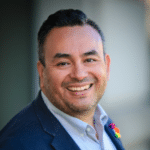Evolution of Association Culture and Flexibility

Before the COVID-19 pandemic, organizational culture was generally slow-to-change and rather inflexible. However, the COVID-19 pandemic, and the year+ of remote work that followed, has had significant effects on workplace culture. It has upended the expectations and practices that once guided our daily actions within the office.
To better understand how associations are addressing culture and flexibility during this unprecedented time, we spoke with four association executives on how their organizations are addressing and adapting to these workforce challenges for the future.
Meet the association executives…
 |
Edward Salek, CAE, is the Executive Director of the Society of Tribologists and Lubrication Engineers (STLE), a technical society that serves the needs of more than 13,000 individuals and 250 companies that comprise of the tribology and lubrication engineering business sector. |
 |
Lindsay Currie, CAE, is the Executive Officer for the Council on Undergraduate Research (CUR), a non-profit organization that supports and promotes high-quality mentored undergraduate research, scholarship, and creative inquiry. |
 |
Nabil El-Ghoroury, PhD, CAE, is the Executive Director of the California Association of Marriage and Family Therapists (CAMFT), an independent state professional organization of 32,000 members that represent the interests of licensed marriage and family therapists. |
 |
Bob Moore, MA, CAE, is the Executive Director of the American College of Osteopathic Family Physicians (ACOFP), a professional medical association that represents more than 18,000 practicing osteopathic family physicians, residents, and students through the US. |
Has your organization had to make significant shifts in their strategic priorities as it relates to organizational culture/flexibility? If so, what was the most significant factor and how did you address this?
Salek: STLE’s culture had emphasized flexibility prior to the pandemic. It is a small organization (10 employees) and we viewed this as a benefit that helped us recruit and retain quality people. However, there was not much structure related to the program. Rather it was more of an ad hoc series of arrangements. Beginning in March 2020, our organization shifted to a fully remote model for several months for obvious reasons. During that time, we developed a hybrid rotational approach that brought 1-2 staff people into the office once a week on an assigned day. This showed us the benefits of combining structure with flexibility. Going forward, we plan to refine this policy into a permanent work philosophy that suits the needs of the organization and its employees.
El-Ghoroury: My organization shifted dramatically regarding physical location (no surprise, given the pandemic). However, it is driving a critical reevaluation of whether jobs have to be physically located in the office. This was slowly beginning before the pandemic as the association hired two remote employees but gained substantial momentum after the entire office went remote 100%.
Moore: Yes, over the last few years we started a telecommuting option (2 months pre-COVID), then went 100% virtual. We will likely only go back 2 days/week. I now will hire remote staff for some positions. We instituted casual dress and summer hours.
Currie: My organization certainly shifted the how, but we did not shift the what or the why.
Working mothers/caregivers are just one example of a segment that was significantly impacted by the pandemic- how is your organization creating a consistent employee experience among these unique segments?
-Lindsay Currie, CAE
Currie: We are an all-female staff; many are mother and/or caregivers. We have always had a flexible structure to allow for accommodating the realities of life. We continued to be sensitive to this during the pandemic. Kids have joined staff meetings, we have shifted schedules to provide space for supporting virtual schooling, and more. Staff have stepped up and covered for others when they know they needed a break. We have welcomed family members to our virtual engagement activities like cookie decorating and writing valentines for a senior center.
Moore: We aren’t instituting a work in the office policy until after Labor Day to ensure kids are back in school and caregiving is pre-pandemic normal.
Salek: We have one working mother on our team and one working father who is a caregiver. In both cases, we embraced their status and gave them permission to make their own decisions on how to balance the needs of childcare with their work responsibilities. The result has been exceptional performance in both cases. Other staff members recognized this and enjoyed the moments when toddlers joined us on video conferences
El-Ghoroury: As Executive Director, I worked closely with supervisors to establish priorities for departments. Some efforts that were less prioritized were consciously placed on the back burner during the pandemic to give some breathing room to parents/caregivers.
The pandemic ushered in other significant workforce issues, such as legal (increase in lawsuits related to discrimination, leave of absence, and work from home policies), health and safety concerns (ADA accommodations, OSHA’s “safe and healthy workplace” and mental health impacts). Was your organization impacted by [these] workforce issues?
El-Ghoroury: The association offers sick time in addition to vacation time (rather than a single PTO system). During the pandemic, I allowed people to use sick time for mental health days. This has gone well and has allowed teams to prepare more easily for some challenging days.
Salek: We have not been directly impacted by any of these issues, but we did make a point of assuring employees that the organization was giving them the freedom to make decisions about health and safety without any repercussions. Our Executive Committee also made it clear that the organization was committed to managing through the pandemic without reductions in salaries or layoffs. I am certain that this helped everyone stay focused on their job and not be stressed about losing that job. We are fortunate to have an elected leadership willing to take that stance despite some serious financial stress on the organization.
Since the pandemic, did your organization identify other workforce issues that were not obvious prior to it? If so, what did you do to address these?
-Nabil El-Ghoroury, PhD, CAE
Moore: Staff don’t all have equal or ideal places to work at home. We gave funds to get offices organized (equipment wise) and some funds each month for supplies and internet. We are keeping the internet to ensure high-speed connections are affordable.
Currie: We have upgraded some technology to make virtual meeting and collaboration easier.
El-Ghoroury: We have been systematically examining workforce issues to address structural issues that may be barriers to people of diverse backgrounds. For example, in recent job descriptions, we have modified required education to allow for a college degree or job experience to serve as an equivalent, rather than have an expectation that a position require a college degree. We have also been asking questions about diversity in interviews for all positions, including entry level positions.
Salek: For our organization, the biggest issue relates to having a 12,000 sq. ft. office building that is owned by the organization but oversized for the number of employees. The issue is complicated by the realization that people enjoy work-from-home flexibility and are producing good results. We are struggling with how to best utilize this building as a physical home for the organization and as a productive asset. I’m aware of several other organizations that own buildings dealing with the same issues.
Many organizations have begun to implement new HR policies to address these issues, such as flexible scheduling and work-from-home. Has your organization found any new or creative solutions that they have adopted to address these issues?
Salek: We are working on a handbook review now. We also brought in an external consultant that specialize in building strong virtual office cultures to help guide us through. We are in the process now.
Moore: Not yet. but we’ll likely be back 2-3 days in the office, and one may be when everyone comes in for a staff meeting and team building activity.
Currie: We are among the organizations working to implement new HR policies, including those cited. I can’t say anything would qualify as new or creative at this point.
How is your organization planning in terms of policies and processes to address these issues (for example, if you have open positions due to these issues, how do you plan to recruit for them now)?
-Edward Salek
Currie: We are continuing as a virtual org and not going back to an office. This has allowed a staff member to move out of the area to be closer to family and we have added new staff that are located in another state.
Salek: Geographic flexibility is probably the biggest change post-pandemic. The traditional mentality of seeking employees within a certain travel distance from the headquarters office was often a restriction on talent acquisition. Recognizing that people can work in remote locations and still be highly effective is a change for the better.
How do you think organizations can continue to evolve their organizational culture and flexibility as things move forward?
Salek: Organizations will need to demonstrate that the culture and flexibility are supporting the overall goals of the organization. A great culture alone is not enough. Demonstrable results need to be part of the culture. Toward that end, I see successful organizations making greater use of solid metrics to confirm results.
Currie: Intentionality. But many orgs still seem against this flexibility, and I would challenge them to identify why. We have been more productive, and our team has grown closer in a virtual environment, because culture was a priority.
El-Ghoroury: I think a major issue is flexibility at the top. Results matter, and as CAMFT transitioned to 100% remote work, it became evident that we were able to produce results without physically being in the office. This made a huge impact on staff members who were reluctant to support remote work.
Tags
Related Articles
Refill Your Cup: Summer Wellness Tips for Busy Professionals
Discover simple, effective ways to recharge this summer so you can show up as your...
Rewirement: A New Approach to Retirement
Retirement doesn’t have to mean stepping away—it can be a thrilling "rewirement" into a purpose-driven,...
Career Corner Roundup
Every single Career Corner article we published in 2024!




